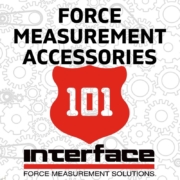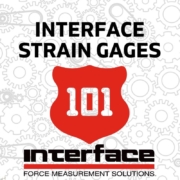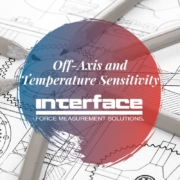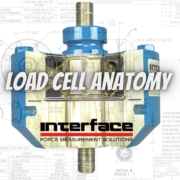Understanding Cable Length and Temperature Effects
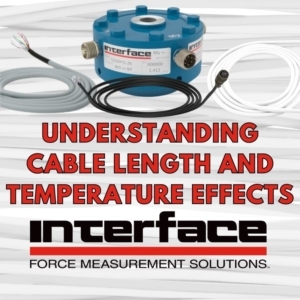 Interface offers several different accessories, from interconnect cables and mating connectors to base kits and TEDS. Cables and connectors are used to attach the sensor equipment to a multitude of components and systems including data acquisition systems, power amplifiers, test stands and other instruments.
Interface offers several different accessories, from interconnect cables and mating connectors to base kits and TEDS. Cables and connectors are used to attach the sensor equipment to a multitude of components and systems including data acquisition systems, power amplifiers, test stands and other instruments.
Consideration of the cable and connectivity are important when selecting any transducer. Interface has several standard cable options based on the type of measurement device, the instrumentation, the pinout, type of connector and length required for the testing use case.
 Find a range of all standard cable assembly options listed here, such as:
Find a range of all standard cable assembly options listed here, such as:
- Interconnect Cable from Bayonet-Type Load Cell Connector to Pigtails, 10-foot in length
- Amplified Load Cell Bayonet-Type Connector to Pigtails
- Screw-type Load Cell (non-TEDS) Connector to Model 9860 Indicator 10-foot in length
- Interconnect Cable from Model TS-type Torque Transducer to Pigtails, 10-foot in length
- Interconnect Cable from Pigtails to Pigtails, 10-foot in length
- Interconnect Cable from TX Torque Transducer 8-pin Connector to Pigtails, 6-meters in length
- Interconnect Cable from Model WMC/2420/2430 Bayonet-type Load Cell Connector to Pigtails, 10-foot in length
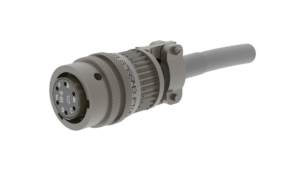 Interface uses the highest grade mating connectors to ensure that the performance of your force and torque solutions are not compromised during use. We offer options for standard connectors based on the receptacle and plug type requirements, as well as custom solutions. Our mating connectors include:
Interface uses the highest grade mating connectors to ensure that the performance of your force and torque solutions are not compromised during use. We offer options for standard connectors based on the receptacle and plug type requirements, as well as custom solutions. Our mating connectors include:
- Bayonet-Type Mating Connectors
- Screw-Type Mating Connectors
Cable Length and Temperature Considerations
For high accuracy force measurement, the effects of the cable on the measurement must be considered for any testing program. For constant voltage excitation there are two significant effects:
- An effect on the sensitivity due to voltage drops over the cable length.
- An effect on the thermal span characteristics of the load cell due to the change of cable resistance with temperature.
If the Interface load cell is purchased with a cable of any length, the sensitivity is determined with the installed cable in calibration. Always consider your cable options when buying a new sensor.
TIP: For load cells with connectors, or if a cable is added that is not designed for the exact use, there will be a loss of sensitivity of approximately 0.37% per 10 feet of 28 gage cable and 0.09% per 10 feet of 22 gage cable. This error can be eliminated if a six wire cable is run to the end of the load cell cable or connector and used in conjunction with an indicator that has sense lead capability.
Since cable resistance is a function of temperature, the cable response to temperature change affects the thermal span characteristics of the load cell cable system. For 6-wire systems this effect is eliminated and is a non-issue in performance. For 4-wire cables the effect is compensated for in the standard cable lengths offered with the load cells if the load cell and cable are at the same temperature at the same time.
There are cables designed for hot temperature or corrosive environments that can not only withstand those conditions, but also provide accurate data despite environmental challenges.
TIP: For non-standard cable lengths, there will be an effect on thermal span performance. The effect of adding 10 feet of 28 gage cable is to cause a decrease in sensitivity with temperature equal to 0.0008%/°F. For an added 10 feet of 22 gage cable the effect is to decrease sensitivity by 0.0002%/°F. In some cases, it is tolerable to degrade performance since Interface standard specification is extremely tight. However, for long cable runs or high accuracy applications, this can be a significant factor. The best approach to eliminate the problem is to run six wires to the end of the standard cable length and sense the excitation voltage at that point.
Our customers in the oil and gas industry often need force measurement solutions that can perform under extreme heat and pressure, such as in a downhole application. The cables and connectors needed for this type of project often need custom braiding and coating to ensure the wiring will not melt or corrode in this environment. Read more in Interface Pressure Compensated Downhole Load Cell White Paper.
Interface also provides our maritime and off-shore testing customers with submersible solutions in which the connection between the submersible load cell and the connector must be sealed tightly to prevent water damage to the components.
We develop all our products and accessories using only components and materials that are engineered to perform for precision testing applications. Find all the accessories here. Our engineers will also work with your directly to find the accessories that fit your specific needs. If we do not currently offer the necessary connectors and cables in house, we can work with you to create a custom solution. We also provide a variety of options depending on the data requirements, whether it is permanent monitoring, as well as different cables based on instrumentation interconnectivity.
The best option is to always purchase the cable and any mating connector at the time you choose your load cell or torque transducer. This ensures it is calibrated with the cable and performs to the exact specifications as it was designed and guaranteed by Interface.
ADDITIONAL RESOURCES
Demystifying Specifications Webinar

